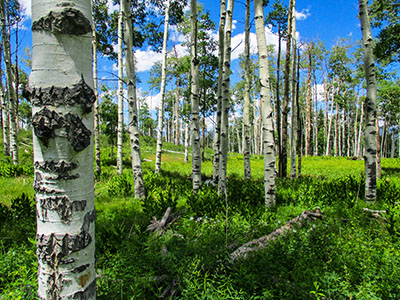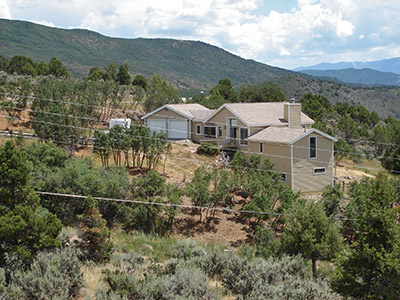Grand Junction Field Office – Forest Management & Stewardship
At the Grand Junction Field Office, we are dedicated to providing quality assistance to landowners in Delta, Garfield, Mesa, Pitkin and Rio Blanco counties by helping them achieve their resource management goals.
Quick Links
- Piñon-Juniper Management
- Piñon Ips Bark Beetle
- Gambel Oak Management
- Contractors List
- Programs for Landowners
The Grand Junction Field Office’s forest management programs provide a variety of services to Colorado landowners. We are dedicated to providing quality assistance to landowners in Delta, Garfield, Mesa, Pitkin and Rio Blanco counties by helping them achieve their resource management goals.
Our goal is to help landowners enhance, protect and manage their forest property for optimum health now and for future generations.
Services include assistance with the following programs:
- Forest management plans
- Thinning projects for forest health and restoration
- Fuels reduction and modification to reduce wildfire hazards
- Insect and disease surveys and detection
- “Sick tree” calls — site visits for both large- and small-acreage properties
- Conservation tree planting plans
- Seedling tree planting and advice
- Advice and assistance in coordinating forest contractors and consultants
- Public education and dispersal of information
- Seminars and workshops for communities, subdivisions and homeowner associations
As a Colorado landowner, you can enhance the value of your forestland by being dedicated and concerned about forest management issues and wildfire. Managing your land will not only increase the value and health of your resource, but also will enhance and protect wildlife habitat, soil and water quality, and ecological diversity.
Please contact the Grand Junction Field Office if you have any questions about managing your forest property.
Piñon-Juniper Management
 Piñon-juniper woodlands account for more than 5 million acres or approximately 21 percent of the state’s forested lands. Piñon-juniper woodlands are widespread in the lower elevations ranging from 4,900 to 8,000 feet in Western Colorado and exist in limited distribution in south-central Colorado and on the Eastern Plains.
Piñon-juniper woodlands account for more than 5 million acres or approximately 21 percent of the state’s forested lands. Piñon-juniper woodlands are widespread in the lower elevations ranging from 4,900 to 8,000 feet in Western Colorado and exist in limited distribution in south-central Colorado and on the Eastern Plains.
The most common species within piñon-juniper woodlands are Colorado piñon pine (Pinus edulis) and Utah (Juniperus osteosperma) and one-seed (Juniperus monosperma) juniper, although Rocky Mountain juniper (Juniperus scopulorum) may codominate or replace one-seed juniper at high elevations.
Although not a traditional timber species, piñon-juniper forests have long been important to local communities for such products as fuelwood, fence posts, pine nuts, forage for livestock and watershed protection. Piñon-juniper forests also provide habitat for many of Colorado’s rarest plants as well as one of the state’s rare birds, the gray vireo.
Piñon Ips Bark Beetle
In western Colorado, piñon trees are under attack from a native insect, the piñon Ips bark beetle. This insect can successfully attack and kill piñon trees that are in poor health or stressed due to drought conditions or other environmental factors. Trees that are healthy and receive the appropriate amount of water (be careful to not overwater piñon trees in the landscape) are usually able to fight off attacks by this bark beetle. There are actions that homeowners can do to lessen the damage by this insect and in some cases prevent or reduce the numbers of attacks.
The piñon ips bark beetle has multiple generations per year and are flying and looking for susceptible host trees from mid-April/May to late-Sept/October. They are attracted to the smell of stressed trees and the smell of freshly cut, green (live) piñon trees. It is critical that during times of high Ips beetle populations that homeowners do not cut green piñon trees while the beetles are active in the summer. However, it is ok to cut dead material any time of the year, including dead trees and dead branches.
The Colorado State Forest Service put together a very helpful quick guide on the piñon Ips, visit the Common Insects and Diseases of western Colorado page to view the quick guide and learn about other pests that can impact our piñon trees.
It can be difficult to determine if your tree has been attacked by the Ips bark beetle. Below are some resources to help you make that decision:
- Photos to help identify whether or not your tree has been attacked by the Ips bark beetle can be viewed here (6 MB PDF).
- Video of a piñon tree infested with piñon Ips.
- Video of a piñon tree with dieback in the crown but not killed by piñon Ips.
- Video of a piñon tree attacked by the piñon pitch mass borer. For more information on the piñon pitch mass borer, visit the Grand Junction Common Insects and Diseases page.
For more information on how to protect your tree read the Protecting Your Piñon Trees (415 KB PDF). Slash management is very important when dealing with piñon Ips and tree removal, for information on proper slash management, view Slash Management With Regard to Ips (250 KB PDF). Winter watering can also make a big impact on your tree’s health, for details on how to properly winter water, view the Winter Watering Fact Sheet (1.6 MB PDF).
For more information check out the CSFS Piñon-Juniper page or the National Park Service Piñon-Juniper page.
Pests that attack piñon and juniper trees can be found on the Grand Junction – Common Insects and Diseases page.
Gambel Oak Management
 Gambel Oak (Quercus gambelii) is a native shrub, also known as shrub oak. These oak shrublands account for 10 percent of the forested lands in Colorado and are found throughout most of western Colorado. Their appearance can range from dense thickets with little understory to open groves of tree like oak stems with a rich understory of shrubs, grasses and wildflowers.
Gambel Oak (Quercus gambelii) is a native shrub, also known as shrub oak. These oak shrublands account for 10 percent of the forested lands in Colorado and are found throughout most of western Colorado. Their appearance can range from dense thickets with little understory to open groves of tree like oak stems with a rich understory of shrubs, grasses and wildflowers.
Fire usually plays an important role in maintaining oak shrublands; it promotes regeneration, controls the invasion of trees and increases the density and cover of Gambel oak and serviceberry. Wildlife species associated with oak shrublands include sharp-tailed grouse, blue grouse, Merriam’s turkey, Abert’s squirrel, mule deer, elk and black bear.
For more information, read Oak Management Fact Sheet (3 MB PDF) or Gambel Oak Management in Western Colorado (17 KB PDF).
Contractors List
The Grand Junction Field Office retains a list of local contractors who have asked to be on this list. We do not endorse any contractor and provide the listing only as a service to homeowners. Homeowners are advised to compare services and prices to find the contractor best suited for their particular needs.
We are aware of contractors working in the following areas:
- Consulting Forester
- General Tree Cutting
- Logging/Salvage
- Sawmill/Wood Processing
- Wood Product Purchasing
- Defensible Space Thinning
- Chipping/Slash Removal
- Wildfire Mitigation Plans
- Pile Burning
- Post-Wildfire Rehabilitation
- Mountain Pine Beetle Diagnosis
- Insect Spraying
View the current Grand Junction Field Office Contractors List (150 KB PDF) or contact our office at (970) 248-7325.
If you are a local contractor and would like to be on this list, please fill out this Forestry Contractor Information Update Form (22 KB DOCX).
Programs for Landowners
Forest Ag
The Forest Agriculture Classification Program allows forested lands that meet specific specifications to have similar property tax valuation as that of traditional agricultural lands. The Forest Ag program is voluntary and landowners must meet annual requirements for eligibility. These include:
- The landowner must perform forest management activities to produce tangible wood products for the primary purpose of obtaining a monetary profit. Tangible wood products include transplants, Christmas trees and boughs, sawlogs, posts, poles and firewood.
- The landowner must have at least 40 forested acres.
- The landowner must submit a Colorado State Forest Service-approved forest management plan that is prepared by a professional forester or natural resources professional.
- Landowners must annually submit (1) a request for inspection, (2) an inspection fee, (3) an accomplishment report, and (4) an annual work plan for the following year. The enrolled property must be inspected annually by a CSFS forester.
More information can be found on the CSFS Forest Ag page or contact the Grand Junction Field Office.
Tree Farm
A tree farm is a tract of privately owned land that is voluntarily dedicated by its owner to the growing of renewable resources, while protecting environmental benefits and increasing public understanding of sustainable forestry.
More information can be found on the CSFS Tree Farm page or contact the Grand Junction Field Office.
Environmental Quality Incentive Program
The Environmental Quality Incentive Program (EQIP) provides a source of funding and technical assistance through the Natural Resource Conservation Service (NRCS) to support forest management activities.
For NRCS office contact information, please visit our Local Partners listing or visit the Natural Resources Conservation Service website for the locations of their Service Centers.

